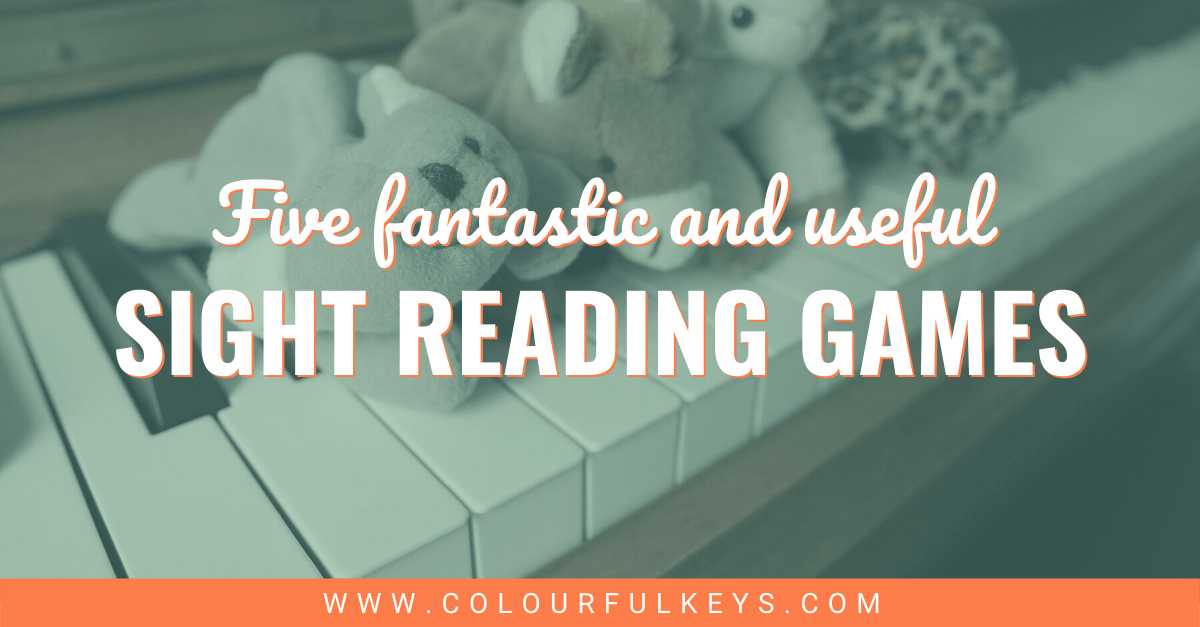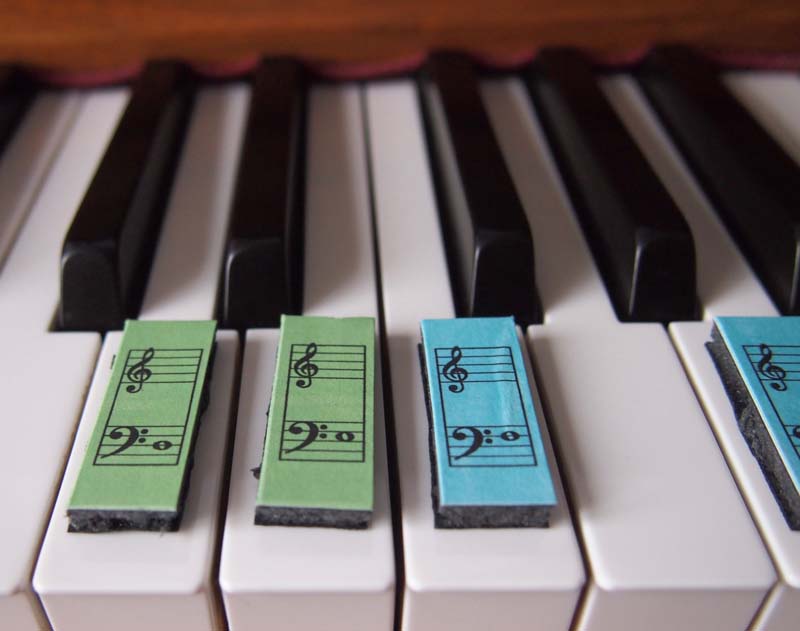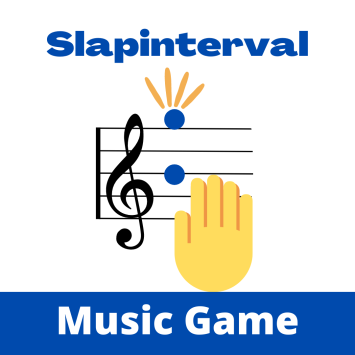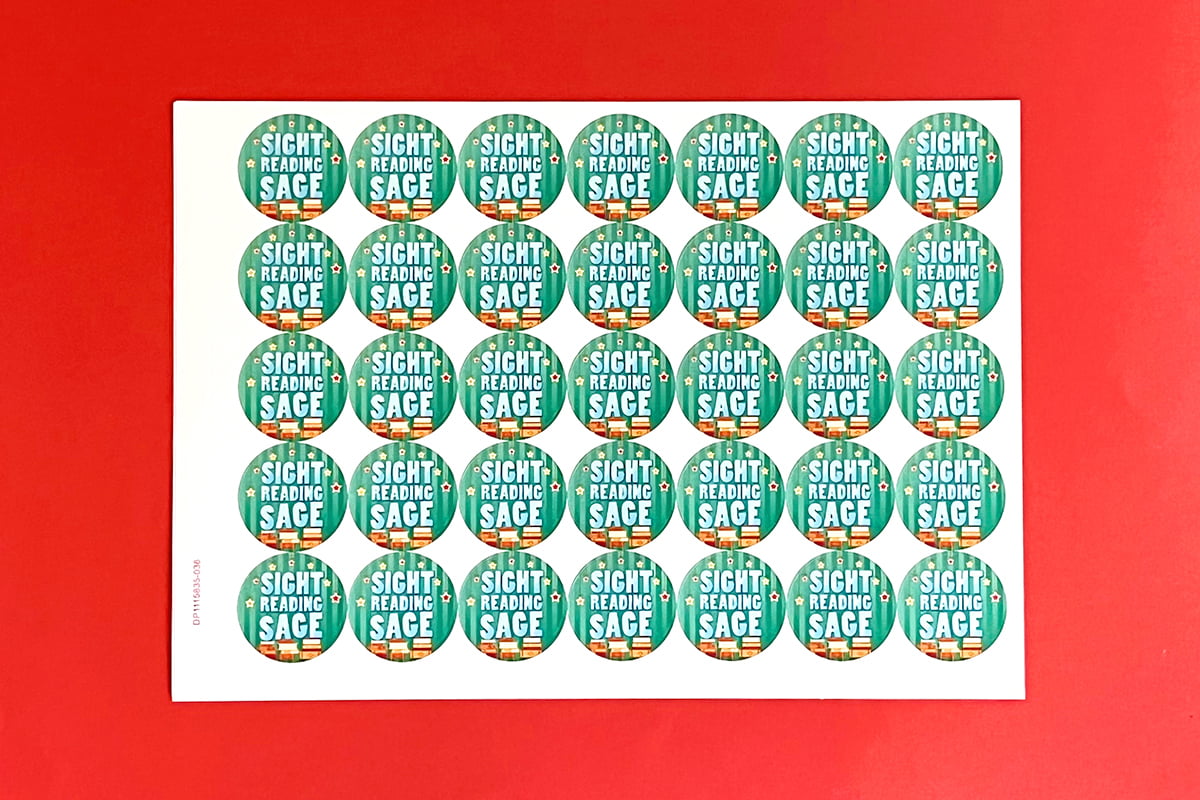
This blog post about turning sight reading into a game for piano students was written by Heidi Neal. Heidi is a teacher of 20 piano students and mom of 6 in Rexburg, Idaho in the United States. She loves biographies, piano blogs and family history. She’s been sharing piano-teaching tips on her blog for 12 years, and loves to use creative and fun activities to spark joy in her piano lessons with children.
Imagine cliff diving blindfolded into unfamiliar waters without knowing what’s below. Are your students feeling cliff-diving-like fears when asked to sight read?

Sight reading can feel scary, but adding fun to the process with sight reading games can help tackle your piano students’ fears of on-the-spot playing.
Although sight reading will always include unfamiliar territory, students can assess the tricky spots in new music more quickly if they’ve paved the brain pathways first.
I’ve found that great sight reading relies on these paths:
- Identifying starting notes
- Recognising intervals quickly
- Spotting chord shapes
- Finding recurring patterns
- Playing with continuity and flow
Any games which help students develop fluency in these areas will help them improve their sight reading. Here are 5 of my favourites.
Piano Sight Reading Game #1: Spy and Fly
Spy and Fly is a quick sight reading game where students practise spying musical elements before they simply into the music.
How to Play
- Grab a die (or interval cards) and 2 game markers (such as buttons, erasers, etc.) to transform your student’s music into a game board.
- Take turns rolling the die and flying forward in the music to the next measure where they spy their target. The first one to reach the last measure of the piece wins.
Choose targets in their music for them to “fly” to based on the concepts you want them to focus on:
- Note names: 1=A, 2=B, 3=C, 4=D, 5=E and 6=F or G
- Intervals: 1=Unison, 2=2nd, 3=3rd etc.
- Chords: 1=I chord, 4=IV chord, 5=V chord, 2, 3 or 6=move forward that many measures
Allow the student to choose one of these “magic number rules” or create their own:
- Speedy Sixes (magic #)= Name 2 terms or expressive symbols in your music to move ahead 6 measures.
- Tricky Twos (magic #)= Swap places with your opponent on the board.
Piano Puzzle Flashcards
If your students need help with connecting notes on the staff to the piano keys, you would love our Piano Puzzle cards. These would be a great primer for Heidi’s game above!

Subscribe to updates and get the Piano Puzzle cards.
Enter your details to subscribe to the newsletter for piano teachers with information, tips and offers.
I hate spam as much as you do! I'll only send you information that's directly relevant to music teachers and you can unsubscribe at any time.
Psst! Are you a member of Vibrant Music Teaching? You can download them in one click here.
Piano Sight Reading Game #2: Slapinterval
Slapinterval (a musical variation of slapjack) is a favourite activity at group lessons in my studio. It can also be used when teaching sight reading in a one-on-one piano lesson setting or in buddy lessons.
How to Play
This game is played just like slapjack, but using intervals instead of jacks. Select a target interval for each round (6th, 4th etc.). The goal is to win the most cards by being the first to slap each target interval card as it’s played in the center.
- Deal cards out equally to the players.
- Players take turns placing a card face up in the center.
- When a target interval is played, whoever is the first to slap it gets to take the whole centre pile of cards.
- If a player slaps an incorrect interval, they must give one of their cards to whoever played that card.
- Once all the cards have been turned, the player with the most cards wins.
More Interval Game Ideas
Any activities which focus on spotting intervals quickly can help sharpen a student’s sight reading skills.
- Start by asking students to spy and colour specific intervals in their music within a target time frame. “How many 4ths can you can find and colour in ten seconds?”
- To ramp up the difficulty, try a 60-second interval challenge by swapping out note flashcards with interval flashcards as students race to say and play them. The Minterval Challenge is perfect for this, complete with tracking charts and challenge stickers.
- Use interval cards in place of dice to adapt other music games.
- Games like Swifterval and Nimble Neighbours can be played in a flash without taking up a lot of lesson time.

Piano Sight reading Game #3: Flying, Falling, Bumps and Pieces
Spotting familiar chord shapes prepares students to sight read pieces with thicker harmonic textures. When students see chunks, patterns and repetition rather than strings of unrelated dots, they can scan and play new music more quickly.
Visual learners might benefit most from associating chords with colours to speed up the harmonic analysis of music, whereas tactile learners might remember metaphors which relate to the “feeling” of the chords.
So before gameplay begins, I like to explain these analogies I use for primary chords:
- I − The I chord often starts and ends a piece and has a restful sound. ‘Home is where the (red) heart is.’
- V (1st inversion) − When your snowman chord goes on vacation to a hot sunny place (yellow) he starts to melt. Feel your hand falling down on the keys to reach the ‘melting’ shape.
- IV (2nd inversion) − To move from the I chord to the IV chord, stretch your hand higher like it’s flying up towards the blue sky.
How to Play
- Grab a timer or stopwatch, coloured pencils and the student’s music.
- Help them identify and mark the first primary chord they see for each colour.
- Then give a series of quick timed “I Spy” challenges suited to the student’s ability:
- Can you find and label 5 red (I) root chords in 10 seconds?
- Do you think you can spot and colour the rest of the ‘falling’ (V) chords (or melting chords) in 20 seconds?
- Set the timer and watch your student’s focus soar as they quickly analyse and colour the chords in their music.
You may wish to follow up with questions to help them spot repeating chord patterns:
- How many authentic/perfect cadences (V-I) can you find?
- Which 3 lines in the music have matching chord progressions?
Although I tend to skip the colouring process for sight reading, the fluency which students develop from consistent chord ID practice makes it easier for them to spot and play the flying and falling (inversions), bumps (V7) and pieces (intervals) in new music.
I love Nicola’s centralised hub page on Planning Piano Lessons. It has so many amazing ideas for gamifying music lessons!
Piano Sight Reading Game 4: Fight Your Foe
Adding colour-coded lines, labels or stickers above phrases or sections helps students to see the big picture of how the music fits together rather than just seeing individual notes.
Use guiding questions to help your student mark different sections in their music:
- Draw a purple line above the measures with this interesting rhythm.
- Are these phrases the same or different?
- Can you spot a phrase with the same shape (sequences)?
- Add happy (major) and sad (minor) emoji stickers to show the mood changes.
- Put an open-mouth-emoji sticker where you need to stretch open your hand for a larger interval or hand shift.
How to Play
- After labeling the sections in the music, ask your student to choose an imaginary opponent (Darth Vader? The Tooth Fairy? Rival Sports Team?) and choose a card from a deck of playing cards.
- Then have them slowly play through the first section of their music.
- If they can play the section with correct rhythm and note names on the first try, they keep the number of points on their playing card. If not, their opponent scores the points.
- Spice it up a bit with comments and analogies like, “Is Darth Vader is going to steal your shooting star?” or, “Will the Tooth Fairy take over your slippery slopes?”
- Repeat until the student or their opponent scores 20 points.
- Adapt the length and difficulty as you go based on the student’s attempts.
Piano Sight Reading Game #5: Slow, Look and Listen
I make a game out of sight reading samples by asking students to aim for playing 30, 40 or 50 consecutive measures without errors to earn their sight reading challenge badge.
How to Play
- Start with simple sight reading samples like Reading Railroad 1 − Steppers, Diane Hidy’s Sight Reading Sets, Michael Kravchuk’s hands-together samples or any music one level below your student’s current ability.
- Students choose the tempo and I play along with them in a lower octave until they can hear when the note or rhythm they played does not match mine.
- Pause between pages so students can scan over the music to prepare for the next level.
- Ask guiding questions. Do you spot any repeating rhythm patterns? How is this page different from the previous one?
It doesn’t take long for students to notice that choosing a slower tempo leads to more success. The pressure and focus starts to build a bit as they get closer to their goal.
This process preps them for future accompanist experiences where looking forward in the music and playing without pausing is imperative.
What game will you use next to train your students to look before they leap?
Do you like timers? Colours? Slaps? Or maybe you have another sight reading success secret?
We’d love to hear your sight reading strategies, game ideas or success stories in the comments below.



Very helpful. Thank you. I think beginner piano courses like piano for all and others could also help beginners to learn piano. It is all about making piano learning fun and easy for beginners. Piano for all details here https://musicgny.com/piano-for-all-review/
I was very interested in the chord pictures used. These seemed to focus a the commonly taught chord progressions using inversions. Has anyone else noticed that these do not show up much in contemporary music? I now introduce all chords in root position. Later on I introduce inversions. I find that students who learned IV and V chords in their inverted form first have trouble identifying the root and can only read off lead sheets if they switch the chord names to Roman numerals.
Hi Beth,
The idea on contemporary classical music, depending on the style of course, is to avoid common patterns and patterns that suggests tonality in general, so a regular IV – V – I cadence will not be seen very often. But you will see great examples of whole tone scales and more interesting things.